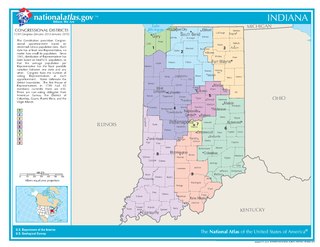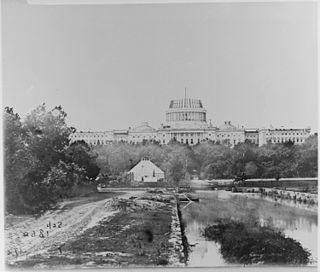Related Research Articles

The 101st United States Congress was a meeting of the legislative branch of the United States federal government, composed of the United States Senate and the United States House of Representatives. It met in Washington, DC from January 3, 1989, to January 3, 1991, during the final weeks of the administration of U.S. President Ronald Reagan and the first two years of the administration of U.S. President George H. W. Bush.

These are tables of congressional delegations from Indiana to the United States House of Representatives and the United States Senate.

These are tables of congressional delegations from Mississippi to the United States House of Representatives and the United States Senate.

The 35th United States Congress was a meeting of the legislative branch of the United States federal government, consisting of the United States Senate and the United States House of Representatives. It met in Washington, D.C. from March 4, 1857, to March 4, 1859, during the first two years of James Buchanan's presidency. The apportionment of seats in the House of Representatives was based on the Seventh Census of the United States in 1850. Both chambers had a Democratic majority.

The 38th United States Congress was a meeting of the legislative branch of the United States federal government, consisting of the United States Senate and the United States House of Representatives. It met in Washington, D.C. from March 4, 1863, to March 4, 1865, during the last two years of the first administration of U.S. President Abraham Lincoln. The apportionment of seats in the House of Representatives was based on the Eighth Census of the United States in 1860. The Senate had a Republican majority, and the House of Representatives had a Republican plurality.

The 50th United States Congress was a meeting of the legislative branch of the United States federal government, consisting of the United States Senate and the United States House of Representatives. It met in Washington, D.C. from March 4, 1887, to March 4, 1889, during the third and fourth years of Grover Cleveland's first presidency. The president vetoed 212 pieces of legislation, the greatest number in a single session of Congress.

James Robert Mann was an American politician and attorney who served as a member of the U.S. Representative for Illinois from 1897 to 1922. He was a member of the Republican party, and served as House Minority Leader from 1911 to 1919.

The 62nd United States Congress was a meeting of the legislative branch of the United States federal government, composed of the United States Senate and the United States House of Representatives. It met in Washington, DC from March 4, 1911, to March 4, 1913, during the final two years of William H. Taft's presidency.

The 45th United States Congress was a meeting of the legislative branch of the United States federal government, consisting of the United States Senate and the United States House of Representatives. It met in Washington, D.C. from March 4, 1877, to March 4, 1879, during the first two years of Rutherford Hayes's presidency. The apportionment of seats in the House of Representatives was based on the Ninth Census of the United States in 1870. The Senate had a Republican majority, and the House had a Democratic majority.

The 46th United States Congress was a meeting of the legislative branch of the United States federal government, consisting of the United States Senate and the United States House of Representatives. It met in Washington, D.C. from March 4, 1879, to March 4, 1881, during the last two years of Rutherford Hayes's presidency.

The 52nd United States Congress was a meeting of the legislative branch of the United States federal government, consisting of the United States Senate and the United States House of Representatives. It met in Washington, D.C. from March 4, 1891, to March 4, 1893, during the final two years of Benjamin Harrison's presidency.

Elections to the United States House of Representatives for the 35th Congress were held at various dates in different states from August 1856 to November 1857.

The Kansas House of Representatives is the lower house of the legislature of the U.S. state of Kansas. Composed of 125 state representatives from districts with roughly equal populations of at least 19,000, its members are responsible for crafting and voting on legislation, helping to create a state budget, and legislative oversight over state agencies.
Expulsion is the most serious form of disciplinary action that can be taken against a Member of Congress. The United States Constitution provides that "Each House [of Congress] may determine the Rules of its proceedings, punish its members for disorderly behavior, and, with the concurrence of two-thirds, expel a member." The processes for expulsion differ somewhat between the House of Representatives and the Senate.

The 2014 United States House of Representatives elections in Virginia were held on Tuesday, November 4, 2014, to elect the 11 members from the state of Virginia to the United States House of Representatives, one from each of the state's 11 congressional districts. On the same day, elections took place for other federal and state offices, including an election to the United States Senate. Primary elections, in which party nominees were chosen, were held on June 10, 2014. On June 10, 2014, Republican Eric Cantor became the first sitting House majority leader to lose in a primary election since the position was created in 1899.
References
- ↑ "INGLIS, Robert Durden, (1959 - )" . Retrieved 13 March 2014.
- ↑ "INHOFE, James Mountain, (1934 - )" . Retrieved 13 March 2014.
- ↑ "INSLEE, Jay Robert, (1951 - )" . Retrieved 13 March 2014.
- ↑ "IRELAND, Andrew Poysell (Andy), (1930 - )" . Retrieved 13 March 2014.
- ↑ "ISAKSON, Johnny, (1944 - )" . Retrieved 13 March 2014.
- ↑ "ISRAEL, Steve, (1958 - )" . Retrieved 28 January 2017.
- ↑ "ISTOOK, Ernest James, Jr., (1950 - )" . Retrieved 13 March 2014.